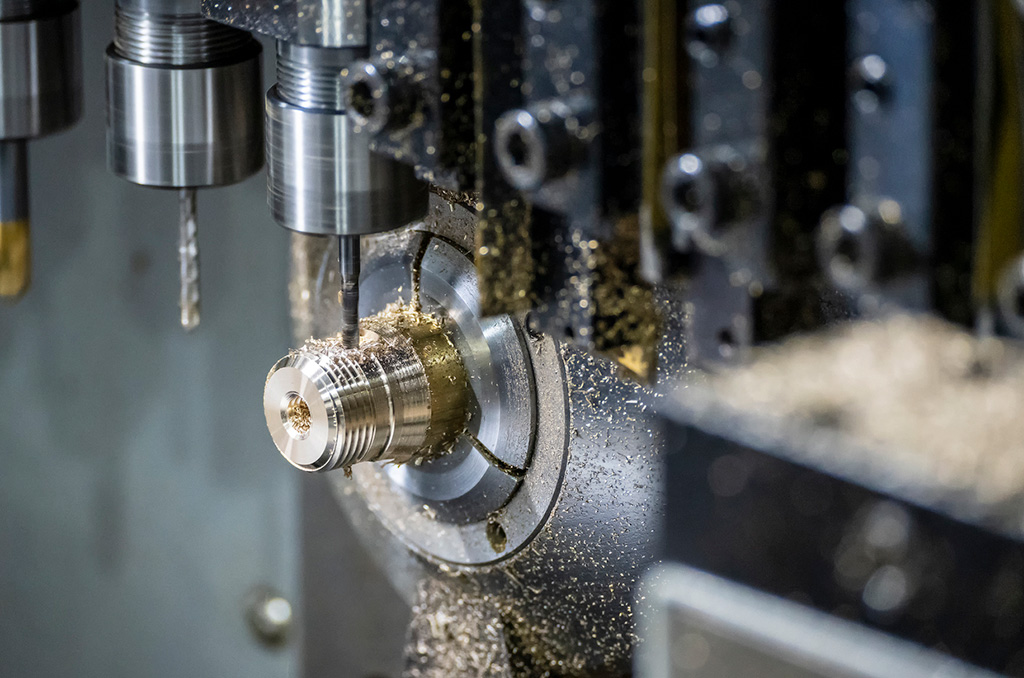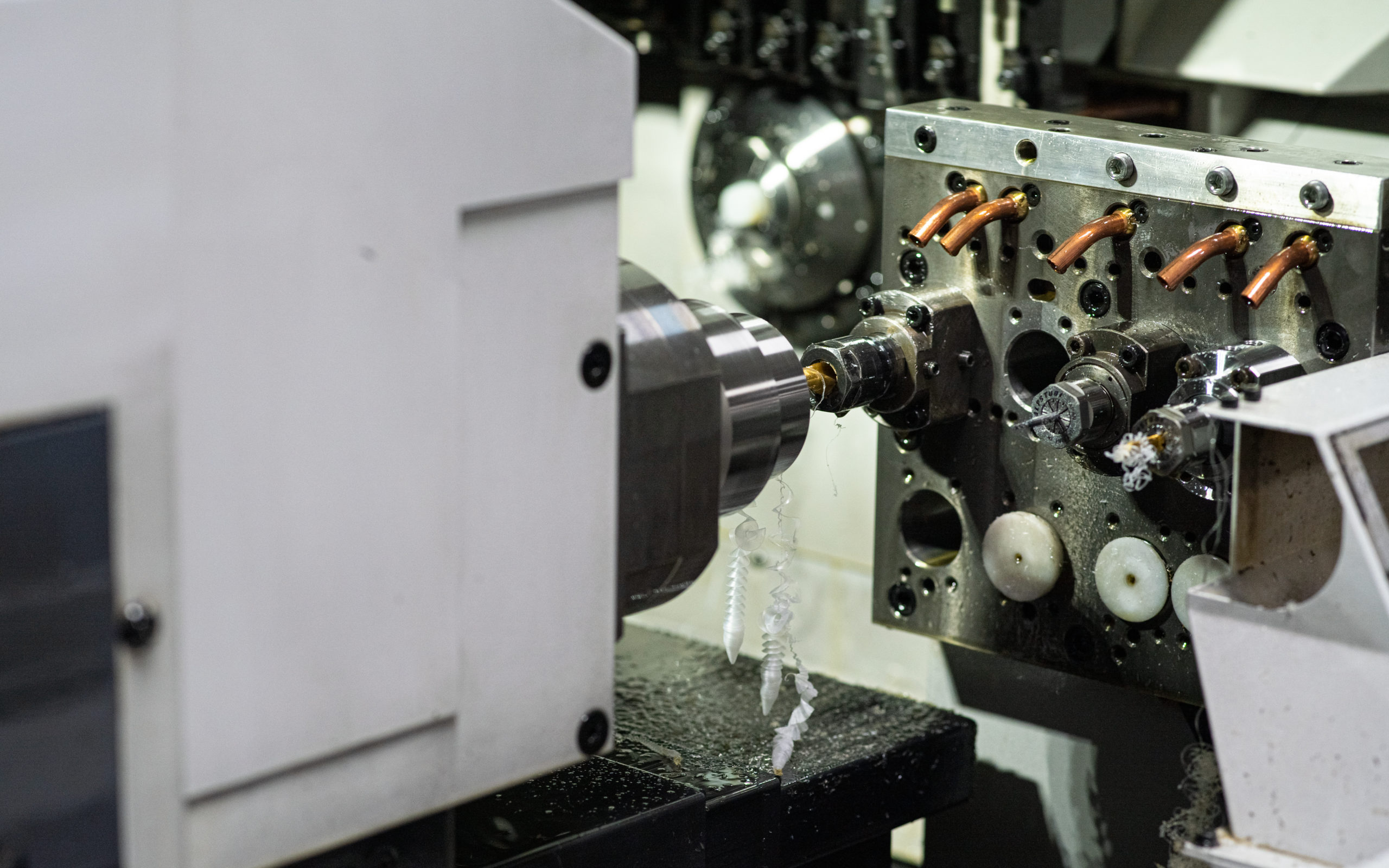Search
What are you looking for?

Swiss turning, also known as Swiss-type turning, is a precise machining process used to manufacture small, complex parts with very tight tolerances. It is typically performed using a Swiss-type lathe, which is a specialized turning center designed for high-precision, small-diameter parts.
Swiss turning originated in the 19th century with the development of the Swiss screw machine (also known as the Swiss Lathe or Swiss Automatic Lathe). It was created in Switzerland to help with the mass production of miniature screws for the burgeoning watch industry. The Swiss screw machine's precision and ability to handle small parts made it an invaluable tool for watchmakers, and the process has evolved to be used for a wide range of industries today.

In the world of precision machining, Swiss turning and conventional turning are two widely used methods for creating turned parts. While both processes are designed to shape materials into specific dimensions, they differ significantly in terms of machinery design, machining operations, cycle time, and overall efficiency. In this article, we'll explore the key differences between Swiss turning and conventional turning, helping you understand when and why each method is suited to different applications.
1. Headstock: Fixed vs. Moving
One of the most fundamental differences between Swiss turning and conventional turning lies in the design of the headstock.
Conventional Lathes: In conventional turning, the headstock is fixed, and the workpiece is typically clamped in place by a collet or chuck. A tailstock may be used to support the opposite end of the workpiece, especially for longer parts. The cutting tool moves toward the workpiece, removing material as the part rotates.
Swiss-type Lathes: Unlike conventional lathes, Swiss-type lathes feature a moving headstock. The workpiece is held in a collet and advanced through the guide bushing along the Z-axis as it is machined. This allows for greater flexibility in machining small parts with a higher length-to-diameter ratio and minimizes deflection during the turning process.
2. Machining Process: Segmentation vs. Single Operation
The machining processes in Swiss and conventional lathes differ greatly in how they handle the workpiece during operations.
Conventional Lathes: In traditional turning, the workpiece is usually machined all at once. The cutting tool moves to different positions to carry out individual operations, changing tools as needed. This process typically handles one operation at a time and is slower compared to Swiss-type machining, as the entire workpiece is exposed to the tool during each operation.
Swiss-type Lathes: Swiss turning is much more efficient due to its segmented machining process. As the workpiece advances through the guide bushing, the cutting tool is able to focus on specific parts of the workpiece at each stage, increasing consistency and precision. This segmented approach allows Swiss lathes to produce intricate geometries more efficiently and with less manual intervention, ultimately leading to higher throughput.
3. Guide Bushing: Stability vs. Deflection
The guide bushing is a key feature that sets Swiss lathes apart from conventional lathes, especially for long and slender parts.
Conventional Lathes: In conventional turning, the workpiece is fixed in place and typically supported by a collet. For longer workpieces with high length-to-diameter ratios, this setup can lead to deflection as the overhang from the collet causes the part to wobble, compromising accuracy.
Swiss-type Lathes: Swiss lathes use a guide bushing to support the workpiece, which is fed into the machine through the bushing. This allows for machining closer to the point of support, reducing part deflection and increasing stability. Because of this added support, Swiss lathes can perform deeper cuts in a single pass, rather than making multiple shallow passes like conventional lathes.
4. Cycle Time: Efficiency and Complexity
Cycle time is an important factor when comparing the productivity of Swiss and conventional turning machines.
Conventional Lathes: Traditional lathes usually require one operation at a time, changing tools for each step, which increases overall cycle time. Depending on the complexity of the part, additional operations and tooling changes may be necessary.
Swiss-type Lathes: Swiss machines are designed for high efficiency, capable of performing multiple machining operations in a single cycle. With the ability to use 7 to 13 axes (compared to 2 to 5 axes on conventional lathes), Swiss lathes can significantly reduce cycle times, particularly for complex geometries. The automatic feed of bar stock further reduces downtime, making Swiss lathes ideal for mass production.
5. Coolant: Lubrication Differences
The choice of coolant also varies between Swiss turning and conventional turning.
Conventional Lathes: Typically, water-based coolants are used to help dissipate heat and reduce friction during machining.
Swiss-type Lathes: Swiss turning uses oil-based coolants, which, although having a lower heat capacity than water, offer superior lubricity. This reduces friction, minimizes heat generation, and helps to prevent tool wear. Oil-based coolants also provide additional protection against rust, extending the life of both the tools and the machine.
6. Post-Processing: Finishing Requirements
Another key difference is the need for post-processing after machining.
Conventional Lathes: Parts produced on conventional lathes may require additional secondary finishing processes, such as polishing, grinding, or deburring, especially if the part has tight tolerances or complex features.
Swiss-type Lathes: Swiss lathes are capable of producing parts with exceptional precision and fine finishes, reducing or even eliminating the need for secondary finishing operations. This is particularly valuable in industries like aerospace and medical device manufacturing, where part quality and precision are critical.
7. Cost: Initial Investment vs. Long-Term Savings
The cost of equipment is a significant consideration when choosing between Swiss turning and conventional turning.
Conventional Lathes: Traditional lathes are generally less expensive upfront, as they are simpler in design and require fewer complex features.
Swiss-type Lathes: Swiss lathes, due to their advanced features, are typically more expensive upfront. However, when used for high-volume production of complex parts, they can prove to be more economical in the long run. The ability to perform multiple operations in a single cycle and reduce machining time often offsets the higher initial investment.

Workpiece Movement: Unlike traditional lathes where the workpiece is stationary and the cutting tool moves, in Swiss turning, the workpiece is fed into the cutting tool, which remains stationary. The part moves along the Z-axis, which allows for extremely accurate cuts, particularly in parts with small diameters and long lengths.
High Precision: Swiss turning machines are capable of achieving very tight tolerances, often in the micrometer range, which is ideal for industries like aerospace, medical devices, electronics, and automotive, where precision is critical.
Complex Geometries: Swiss turning is ideal for parts with complex features, such as fine threads, grooves, and cross-holes, and is especially effective for producing parts with a high length-to-diameter ratio.
High Precision and Accuracy: Swiss turning exceeds the accuracy of traditional fixed-headstock lathes, especially for small, intricate parts.
Small Parts and High Length-to-Diameter Ratios: This method is particularly well-suited for turning parts with long, thin shapes, as it can handle high length-to-diameter ratios.
Efficiency: Swiss turning enables high-volume production of precision parts with minimal material waste and fewer tool changes.
Swiss turning is used extensively in industries that require small, highly precise, and complex parts. Its ability to produce components with tight tolerances and intricate features makes it ideal for applications where precision is critical. Here are some of the key applications of Swiss turning:
1. Medical Devices
Swiss turning is widely used in the production of medical components due to its ability to manufacture small, complex, and high-precision parts required for medical instruments and implants. Common applications include:
Surgical tools (e.g., scalpels, forceps)
Implants (e.g., joint replacements, dental implants)
Needles and catheters (e.g., hypodermic needles, IV catheter components)
Orthopedic devices (e.g., screws, plates)
Medical connectors and housings for electronic devices
2. Aerospace
The aerospace industry requires parts with extremely tight tolerances and high reliability. Swiss turning is used to produce small, complex components such as:
Fasteners (e.g., bolts, screws, and rivets)
Aircraft engine components (e.g., turbine blades, fuel injectors)
Landing gear components
Precision valve parts (e.g., pressure regulators, check valves)
3. Electronics
Swiss turning is essential for producing small, intricate electronic components used in a wide variety of devices. Applications include:
Connectors (e.g., pins, sockets, and terminals)
Sensors (e.g., pressure sensors, temperature sensors)
Switches and micro-mechanical components
High-precision components for mobile devices, computers, and telecommunications equipment
4. Automotive
In the automotive industry, Swiss turning is used to manufacture precision components that are critical to vehicle performance. Common applications include:
Fuel injectors
Valves (e.g., pressure relief valves, control valves)
Electrical connectors
Small engine components (e.g., pistons, camshafts)
Transmission parts
Sensor components (e.g., oxygen sensors, speed sensors)
5. Watchmaking
Swiss turning originated in the watchmaking industry, and it continues to be used today for manufacturing highly detailed, small parts required for watches. These parts include:
Watch components (e.g., gears, springs, pivots, crowns)
Screws and fasteners used in watch assembly
Precise parts for clocks and chronographs
6. Defense and Military
The defense industry relies on Swiss turning for high-precision components that are used in military equipment. Applications include:
Ammunition components (e.g., casings, primers)
Firearms parts (e.g., firing pins, barrel components)
Optical and targeting equipment (e.g., lenses, mounts)
Aircraft and vehicle parts (e.g., landing gear, actuators)
7. Telecommunications
Swiss turning is used to manufacture small parts for telecommunications equipment, which must be durable and precisely engineered. Applications include:
Connectors (e.g., coaxial connectors, fiber optic connectors)
Switches
Miniature fasteners and hardware
Precision components for mobile devices, antennas, and communication systems
8. Robotics
In robotics, Swiss turning is used to produce high-precision components that are critical for robotic mechanisms and automation systems. These applications include:
Actuators
Bearings and spindles
Joints and linkages
Small gears and shafts
9. Optics
Swiss turning is also used in the production of precision optics components that require exact dimensions and smooth finishes. Applications include:
Lenses
Optical housings
Mirror components
Laser components
10. Energy Industry
Swiss turning is applied in the energy sector to create small, complex parts used in renewable energy and other energy-related systems. These include:
Wind turbine components (e.g., shafts, gearboxes)
Nuclear reactor components (e.g., fuel pins, valve stems)
Hydraulic components (e.g., pumps, valves)
Key Advantages in These Applications:
Precision: Swiss turning is capable of producing parts with extremely tight tolerances, often within micrometer ranges.
Complex Geometries: It allows the manufacturing of small parts with intricate features like threads, grooves, cross-drilled holes, and even multi-axis machining.
High Volume Production: Once the tooling is set up, Swiss turning is ideal for producing large quantities of small, precise parts efficiently.
Material Versatility: It works well with a variety of materials, including metals, plastics, and composites.
Swiss turning has become an essential process for many industries that require small, high-performance, and high-precision components.
Flacon MFG is a professional supplier specializing in Swiss machining services, offering both CNC Swiss machining and Swiss turn machining. With a strong focus on precision and efficiency, we are committed to delivering high-quality, complex parts with tight tolerances. Whether you're in the aerospace, medical, automotive, or electronics industry, our expertise ensures that your parts are manufactured to the highest standards.
Our advanced Swiss-type lathes and CNC capabilities allow us to handle small, intricate components with a high length-to-diameter ratio, providing you with exceptional results and reduced cycle times. From prototyping to large-scale production runs, Flacon MFG is here to meet your machining needs.
For custom quotes and further inquiries, don’t hesitate to reach out. Contact us today to discuss how Flacon MFG can help streamline your production process and deliver the precision parts you need.